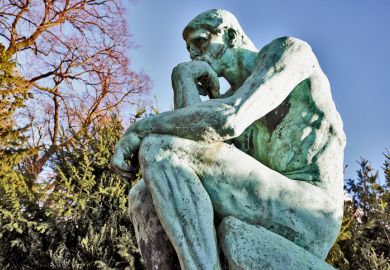A broad journal can bring Etruscology to new audiences, says David Ridgway.
The Etruscans emerged in the 20th century as much more than enigmatic but Hellenised barbarians who preceded the Romans in early Italy. Sadly, the Etruscan writing that has survived is not literary in character; but the significance of Etruscan civilisation is now recognised in the modern academic fields of Classical and European archaeology, ancient history, art history and philology. For obvious reasons, though, Etruscologists are always going to be thinner on the ground than Hellenists and Romanists.
Accordingly, when I heard that Etruscan Studies had begun publication in the United States in 1994, I wondered whether it could survive. I am glad to report that it has, and that its contents are always responsible, usually well informed and sometimes actually useful to the different constituencies that it tries to serve: but I am not yet convinced that the sum of its parts is what modern Etruscan studies outside Italy really need.
From the outset, potential contributors were asked to aim at "professionals in the field of Etruscology, professionals in related fields and interested lay readers". This is a tall and unusual order. Without exception, the likely authors known to me expect to write, in different journals, either for the first field (perhaps with a nod towards the second) or for the third. Happily, lay readers of Etruscan Studies have so far had some excellent demonstrations that new facts can be more interesting than old fiction. Thanks, I suspect, to sensitive editing, some of the best examples of this come from the papers written by, and for, "professionals in the field". Others are embedded in contributions from natural scientists: I think particularly of a topical and well-presented set of papers from a workshop on the relevance of DNA to the subject of Etruscan origins, and of the two papers on Etruscan teeth in the current volume (which will surely inform conversation in dentists' surgeries for years to come).
On the whole, however, I believe that Etruscan haute vulgarisation is better left to the excellent alternative outlets in America ( Archaeology, Expedition and the newer Archaeology Odyssey ) and in the Etruscans' homeland (Archeo, Archeologia Viva - where one of the dentistry articles first appeared in Italian).
It is difficult to cater for the special needs of the second category of readers targeted by Etruscan Studies . Those concerned with the principal "related field", the civilisation of Greece, already have their own problems and priorities, and it could actually be easy for them to miss (perhaps intentionally) an adjacent area of study that is neatly packaged in a single journal. But, given the Etruscans' insatiable demand for Greek art (Greek vases were originally regarded as Etruscan because so many of them were found in Italian cemeteries), it is essential to both sides that Greek and Etruscan specialists are willing and able to appreciate each other's viewpoint. In practice, however, many Hellenists are content to judge the Etruscans and their art by purely Greek standards: a pointless exercise, for Etruscans did not hesitate to adapt Greek artistic ideas to their own un-Greek purposes, in much the same way as they used a version of the Greek alphabet to write in their own language.
In my experience, Hellenists who have not yet understood this require far more remedial teaching than lay people. And although Etruscan specialists rightly regard their subject as far wider and far deeper than the foundations of Roman Italy, Romanists, too, need to pay more than lip service to the historical fact that most Roman citizens in Italy were descended from the Etruscans and their Italic neighbours. In the latter connection, the father of modern Etruscology, Massimo Pallottino, pointed out as long ago as 1975 that "the concept of an 'Etruscan world' isolated, intrusive and virtually antithetic to an 'Italic world' is rapidly becoming a myth".
So far, Etruscan Studies has not achieved much under these headings, and it seems not to have tried very hard. What could be done is illustrated by the brief - sometimes very brief - reviews, notably those by the indefatigable Larissa Bonfante, of specifically Etruscan monographs. Pungent and invariably perceptive, her comments afford a valuable glimpse (all too rare in the English-speaking world) of what is happening at the cutting edge of international Etruscan scholarship, treated as an integral part of the Classical and Italian scenes. But it is no more than a glimpse.
Longer contributions to mainstream Etruscan research fall into two categories: articles and reports from the field. The latter, some of them substantial, consist of progress reports on current, mainly American excavations in Tuscany. The new data that they provide is as valuable as such material always is in any sector of archaeology, and most of these items probably also serve an entirely legitimate purpose in respect of past and future sponsorship. Some fieldwork projects give rise to studies of particular features - such as Anthony Tuck's typological examination of cups from a single site - that illustrate important conclusions (Tuck links the replacement of stylistic diversity by standardisation with the rise of urbanised centres). In this way, Etruscan Studies is providing a useful service to specialists, while showing everyone else what Etruscan archaeologists do.
Two of the specialist articles that particularly interested me were the discourse on method by J nos Szil gyi (Budapest) regarding the serious business of classifying Etruscan bronze mirrors, and Stephan Steingraber's (Tokyo) piece on the funerary architecture of Chiusi. But these are English translations of papers published elsewhere in Italian, and those who can should be consulting and citing the original versions.
In view of the continuing proliferation of conference publications, monograph series and periodical literature in Europe (especially Italy), a full-scale Etruscan translation service is obviously out of the question. But an annotated annual bibliography of the whole Etruscan field - in whatever language - is not, and would be a boon. Meanwhile, there should always be room for papers such as Robert Tykot's thoughtful account (in the first volume) of the early Egyptian, Ugaritic and Hittite documentary references to the Sea Peoples and of the archaeological evidence for East-West contact (with particular reference to Etruscan origins again), which was originally presented at a US meeting.
So far, the highest quality is consistently displayed in the many papers originally read at the Etruscan Foundation's meetings. As well as the DNA workshop mentioned above, there was a "New discoveries and new directions" colloquium in Washington (1993, published 1996) and another on Etruscan bronzes in honour of the doyenne of US Etruscology, the late Emeline Richardson (San Diego 1995, published 1998). Though relatively small in scale, these were important occasions with opportunities for the kind of international dialogue that British Etruscologists can never hope to find in their own country. The results were well worth publishing. Among them, it is good to see a paper by the editor on a hitherto neglected (but not unsuspected) subject: Etruscan humour.
Although there is much that is good in Etruscan Studies as it stands, the time is clearly ripe for a certain amount of decisive fine tuning, and all the more so since adjustment already seems to be in the air. The first five volumes were published in soft cover by Wayne State University Press; the sixth (1999) was issued in hard cover by the University Museum in Philadelphia. These (unexplained) changes provoke a memorable editorial comment: "Ooo-ee, we're walkin' in high cotton now!" I agree, and this is where an English-language journal devoted to the serious study of the Etruscans belongs. Etruscologists everywhere should be grateful to Jane Whitehead for achieving this position for their subject in the competitive world of transatlantic journal publishing. But if it is not to be elbowed aside, Etruscan Studies must build on its strengths. The existing progress reports on fieldwork could be drawn in future from the whole of pre-Roman Italy, as could the matters arising from them, and original (not translated) research papers should be solicited over the same increased geographical range. And, potentially most useful of all, a greatly expanded news and reviews section should certainly run to an annual bibliographical feature, and ideally to abstracts of at least some of the relevant international periodical and other literature (especially exhibition catalogues).
The result would probably be a rather larger journal (no volume has yet reached 200 pages) with a slightly different name ( Etrusco-Italic Studies ?). But it would certainly be one that "professionals in the field of Etruscology" would continue to read and support, and it would be an even more instructive source of information for "professionals in related fields" than it is now.
David Ridgway is reader in classics, University of Edinburgh.
Etruscan Studies: Journal of the Etruscan Foundation
Editor - Jane K. Whitehead
ISBN - www.upenn.edu/pennpress
Publisher - University of Pennsylvania Press
Price - $50 (institut.), or $85 - 2 yrs; $35 (indiv.), or $60 - 2 yrs
Register to continue
Why register?
- Registration is free and only takes a moment
- Once registered, you can read 3 articles a month
- Sign up for our newsletter
Subscribe
Or subscribe for unlimited access to:
- Unlimited access to news, views, insights & reviews
- Digital editions
- Digital access to THE’s university and college rankings analysis
Already registered or a current subscriber? Login



